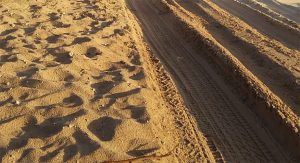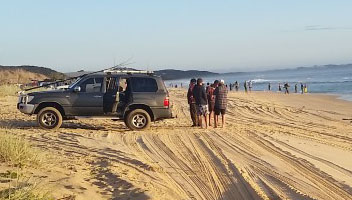Fraser Island Sand Driving Tips
If you are planning a trip to Fraser Island and the thought of driving in the sand scares you a little, then this top 15 list of safe driving practices is a must-read for you.
With over 20 years of experience travelling on and off Fraser Island, we recommend you go through the entire list.
Even if you have experience driving on the sand, it will give you all the tips and tricks and will arm you with the confidence you need to drive safely in the sand.
1. Well-Maintained Vehicle
As a matter of common sense, it is necessary that you have your vehicle serviced by an authorised Dealer or mechanic prior to going on a road trip.
Have the oils checked, inspect the tyre tread and pressure, fluid levels topped, and brake lights and headlights working. Any issues or strange engine noises should be dealt with prior to commencing your trip.
It is a horrible and expensive trip to have your vehicle towed off the island should you have a mechanical problem. It can cost thousands of dollars to recover your vehicle and get it back to the mainland.
Some insurance policies will not cover this due to the remoteness of Fraser Island. It is advisable to check your vehicle insurance policy as a precaution in case of any issues.
Read More: How to Preparation Your 4WD Vehicle for Fraser Island
2. Carry Recovery Gear
A basic recovery kit should include –
- a tyre pressure gauge,
- compact air compressor,
- compact shovel (for digging)
- and a snatch strap.
These items will be useful if you find yourself bogged in sand. Drop tyre pressure first but then remember you will need to inflate back up if they are really low ( -8psi). If this fails a shovel may be needed to dig out sand behind and in front of the tyres. Beware sometimes the sand can be extremely hot.
It’s easy to get carried away with fancy and expensive accessories but the basics are best. They don’t take up much room in the vehicle and won’t cost a fortune.
It is also handy to keep a spare D- shackle, fan belt, tyre puncture kit and radiator coolant in case of a breakdown. These are common problems that occur that can be easily repaired without the need for a mechanic or a tow truck.
3. Not All 4WDs Are Equal
AWD (All Wheel Drive) vehicles were created as a safety feature for modern-day vehicles. They are NOT primarily designed for hard work or off-road use. The focus of the AWD or SUV is on the on-road stability and performance of the vehicle, not the driving conditions that the vehicle will be used.
The biggest problem with SUV and AWB vehicles on Fraser Island is that they do not have the underbody clearance height of a 4WD. Some of the sand ruts from vehicle tyres are too deep for low clearance vehicles as well as soft sinking sand. So higher than standard suspension is required.
Modern and popular 4 x 4 or 4WD are actually made for off-road conditions and harsh terrain. They have added extra comforts and safety features to enhance the driving experience. Add to this, extra accessories that can be added after market that further enhance the vehicle capabilities in harsh conditions.
Fraser Island is definitely a place that only 4WD vehicles should go.
4. Respect The Current Conditions
The most fascinating thing about driving on Fraser Island is how the beach conditions change so rapidly. It is important to remember that with every incoming and outgoing tide, the beach conditions change.
The best advice is to drive along the hardest sand. This is usually close to the water’s edge but obviously not in it.
Keep away by about 3 meters. The softer the sand the harder it is to keep your vehicle from getting bogged.
Stay Low if you want to go!
On one tide the beach can be flat and hard and on the next tide, the sand and beach can be lumpy or extremely soft. Then add to that general changes with the weather. Rain brings poor visibility and deeper creek crossings. Strong wind can whip up mini sand storms and poor visibility also.
Even if you have been to Fraser Island before be mindful that the beach will be different and you will need to drive accordingly.
Don’t be in a hurry, allow plenty of travel time to go between destinations and always wear a seat belt.
5. Watch Other Vehicles To Observe The Conditions
A great little hint when driving on the island is to follow behind other vehicles on the beach.
You will be able to watch when they brake and slow down for creek crossings and sand hazards.
Allow plenty of distance between vehicles, be mindful of your speed, and watch for oncoming vehicles.
6. Check The Tides
Driving on Fraser Island tides is a general rule for visiting Fraser Island. The first thing to do when contemplating a trip is ” Check the Tide” first.
All movement and life on the island are determined by the tide.
To be safe when driving on the island, it is best to travel 2 hours before low tide and up to 2 hours after. This timeframe is optimal for beach travel.
It will allow plenty of hard beach sand to drive on and you won’t get caught on a high tide with waves splashing up over your vehicle or squashed up against a sandbank trying to escape a high tide.
It is terrifying to be caught in a high tide with massive swells and surges. It is an experience that you will want to avoid at all costs.
A rising tide comes up very quickly
7. Use Proper Tyre Pressure
When driving on the island tyre pressure plays a significant role in the comfort and safety of your driving experience.
If your tyres are too hard in soft sand you may get bogged more frequently, and if they are too low it may cause a serious rollover or at the very least a very slow trip.
Generally speaking the softer the sand the flatter the tyres need to be. However, as a guide 12Psi would be a very minimum tyre pressure and only used to get out of a serious bog.
Also See: Best Tyre Pressure For Sand Driving on Fraser Island
8. Engaging 4WD
A 4WD vehicle is an absolute must for driving on Fraser Island. No matter how perfect the beach and weather conditions you will need to engage your 4WD when driving along the beach or the inland tracks.
The newer vehicles are a push button to engage while older 4WD requires a manual gear change and locking in the front wheel hubs.
As soft sand puts up so much resistance that you may have to use 4WD low range. Always be gentle on the accelerator to prevent the tyres from digging in.
Be mindful that when you have engaged 4WD it will affect your steering slightly. Turning sharply will be more difficult.
Also when you are in the little local communities disengage when you drive on grass as the wheels tend to rip it easily.
9. Use Low Gears In Soft Sand
As a general rule with soft sand driving, higher revs, lower gears and maintain momentum. If your tyre pressure is right and you follow this it will help prevent getting unnecessarily bogged.
If you have a manual transmission shifting up in sand will be almost impossible. So, start in 2nd gear low range and keep it there until you are through any real soft spots.
Automatic owners have the luxury of all gears. The automatic gearbox is able to shift without any loss of momentum and provides the needed extra torque.
10. Keep Arms And Body Inside The Vehicle
This may sound obvious but you will be surprised how many injuries arise from people having windows down and arms and heads out flapping about.
Serious injuries and amputations have occurred when vehicles have accidentally rolled over and limbs have been trapped beneath vehicles.
Other injuries have occurred when branches from trees have suddenly hit a person, particularly along narrow inland tracks.
Keep windows up, if possible and keep all limbs in the vehicle.
11. Always Wear A Seatbelt
Like on the mainland, it is mandatory to wear a seatbelt on Fraser Island. That includes the driver and all passengers. There is a resident Police Beat on the island and they do check for seatbelts.
Don’t be complacent because sand driving can be dangerous.
Related: Police Patrol Fraser Island – Be Prepared and Drive Carefully
12. Don’t Turn Sharply
Most of the 4WD that come onto the island are heavily loaded with gear and passengers. These heavy loads can be dangerous for many reasons especially if loads are tied to roof racks on top of the vehicle.
Turning sharply can cause loads to shift or just unbalance the vehicle and cause it to roll over. Many rollovers are due to drivers turning too sharp and too quickly on the soft sand.
Driving straight makes the rear tires follow in the same already compacted sand channel the front tires have created. This causes less resistance and is a safe driving practice.
13. Respect Other Drivers
As Fraser Island is a popular holiday destination there can sometimes be a lot of vehicles and drivers navigating the beach. As a common courtesy and respect for other drivers remember to:
- use your indicator to warn the oncoming vehicle what side of the beach you are going to move towards. Sometimes the tide that washes up will force you to move to higher ground
- Check the rearview mirror for upcoming vehicles that may be trying to overtake
- Be patient. Especially when tracks become blocked due to vehicles bogged in the sand
- Give way on narrow one-way tracks. You may need to reverse back to enable a passing vehicle.
All these small gestures will add to the pleasantries of your trip. Don’t be in a hurry to get anywhere, relax and enjoy the scenery.
Must Read: Common Courtesy and Driving Etiquette Tips For Fraser Island
14. Don’t Drink And Drive
Drink-driving rules apply on the island just like on the mainland. And yes the Island has a resident Police Force that patrol the beach and visit the local communities.
Remember that most people and vehicles travel the beach at restricted times and the police set up speed traps and breathalyser stations. This is to ensure rules are adhered to and drivers are kept safe.
15. Avoid Driving At Night
Night driving on Fraser Island comes with all sorts of dangers. To avoid getting in strife just don’t do it unless absolutely necessary.
The reasons seem obvious:
- low visibility even with high-beam headlights
- hidden washouts in the sand
- hidden debris
- fast incoming tides and surges
- may become stuck in bogg and unable to get yourself out
- may become disorientated or lost
Save the driving for daylight hours it is far more enjoyable and you get to see the incredible views.
Fraser Island Sand Driving Tips Conclusion
In conclusion, the top 15 sand driving tips are important to be aware of for a safe driving experience.
Consider the beach conditions, know the capabilities of your 4WD, prepare yourself with a basic recovery pack and be courteous to other vehicles and people when driving.
I guarantee if you follow these basic tips you will have a much more pleasant driving experience.
You will feel more confident and less likely to get stuck. But even if you do get stuck in the sand you will know exactly what to do first: LOWER YOUR TYRE PRESSURE if this fails bring out the recovery kit !!
Safe and Happy Travels to you all.
ADVERTISEMENT



